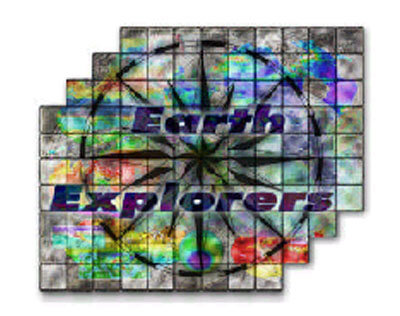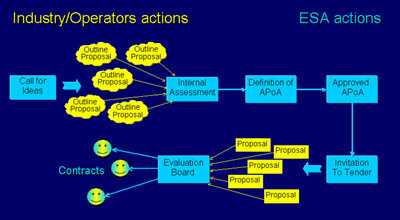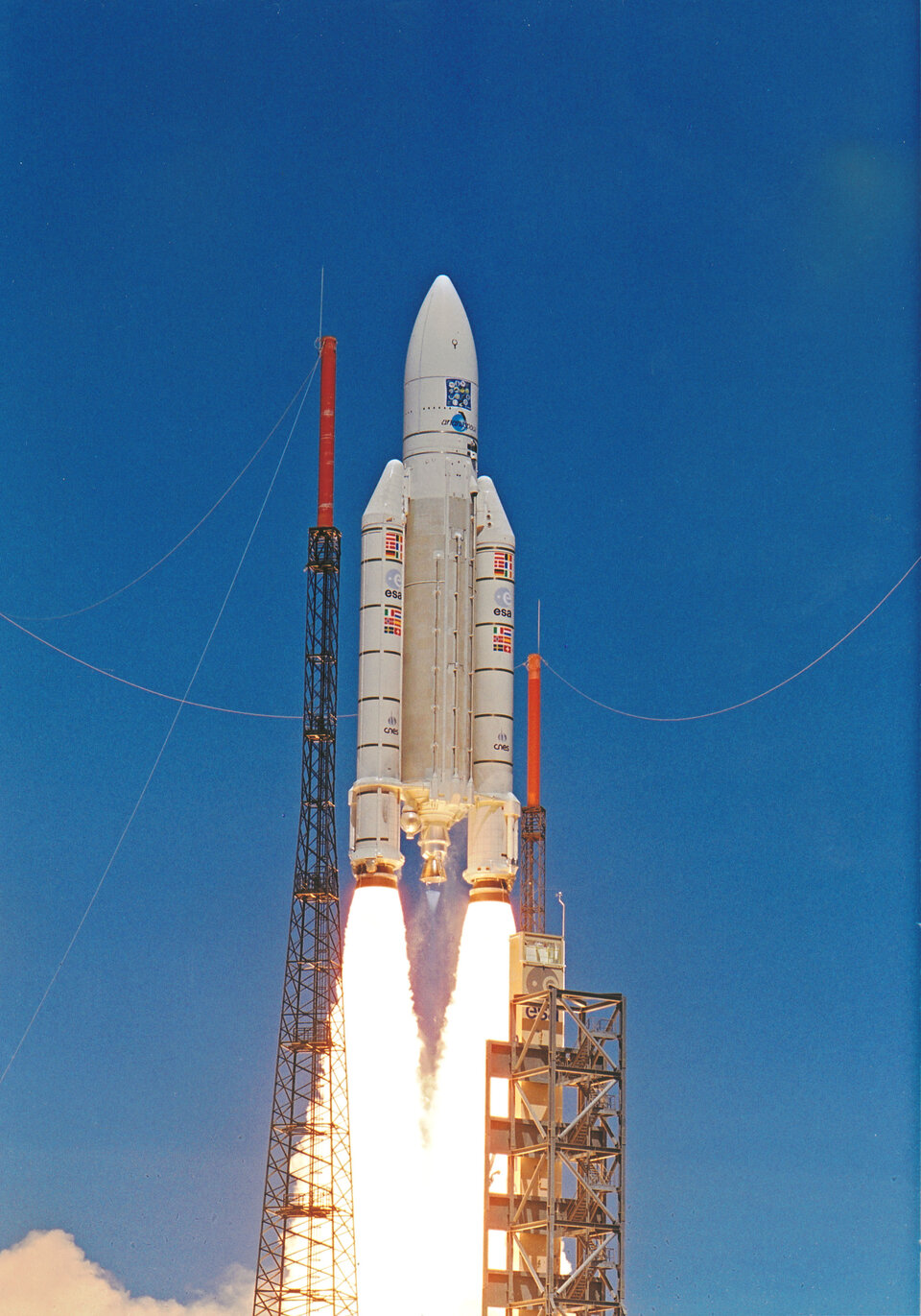The Edinburgh Ministerial Council: Programmes and budgets
ESA Info 12-2001. The programmes tabled for decisions at ESA's Council meeting at ministerial level, held in Edinburgh on 14 and 15 November, covered the Level of Resources (Science and General Budget), Earth Observation, Telecommunication technology and Satellite Navigation, the International Space Station, Launchers and the start of a new European long-term initiative for the robotic and human exploration of the Solar System.
1. THE LEVEL OF RESOURCES
The Level of Resources determines the funding available for the basic activities of the General Budget and for the Science Programme.
The General Budget
The General Budget covers corporate and administrative costs, technical activities such as the basic General Studies and Technological Research Programmes, plus Earthnet and Education (funding of fellowships, etc.).
The total allocated to General Budget for the period 2002-2006 amounts to EUR 825m.
The Science Programme
The funding for the next five years should cover:
- maintenance of plans for scientific missions already launched (Hubble Space Telescope, Ulysses, Cluster II, SOHO, Huygens/Cassini, XMM-Newton)
- approved scientific missions in the development phase (Integral, Rosetta, Mars Express, Smart-1, Herschel-Planck)
- new missions under study or to be chosen and initiated in this period (i.e. the Cornerstones BepiColombo, GAIA and LISA - with Smart-2, and the Solar Orbiter flexi-mission)
The total contribution to the Science Programme for 2002-2006 amounts to EUR 1869m.

2. EARTH OBSERVATION
EOEP-2 Earth Observation Envelope Programme
EOEP implements Earth Explorer core and opportunity missions and also funds mission exploitation, instrument predevelopment and support for market development.
Earth explorer missions such as Cryosat, the Gravity field and steady state Ocean Circulation Explorer (GOCE), the Soil Moisture Ocean Salinity (SMOS) and the initiation of full implementation of the Atmospheric Dynamics Mission (ADM-Aeolus) are major achievements of the first phase of this programme.
The second phase, EOEP-2, will give the Earth Science community and industry a stable outlook in which one new mission will be launched every year. It will also cover preparation of Earth Watch missions.
The financial commitments from member states for EOEP-2 amount to EUR 926.44m for the period 2003 -2007.
Earth Watch
The Earth Watch initiative will include a number of Earth Observation missions supporting public and private-sector applications such as mapping, natural resource management, major risks and security, geology etc. Earth Watch will also cover the requirements of the GMES initiative, currently being drawn up with the European Commission, addressing in particular global change, natural and man-made hazards, environmental stress and monitoring of treaty commitments.
The financial commitments from member states for Earth Watch Slice 1 cover the period 2002-2006:
- GMES service elements: EUR 83m.
- thematic L/X SAR element based on the joint proposal from the British and German space agencies (BNSC/DLR) for Infoterra/TerraSAR: EUR 25m.
- consolidation of the infrared element based on the Spanish CDTI Fuegosat proposal: EUR 9m.

3. TELECOMMUNICATIONS
Advanced Research in Telecommunication Systems (ARTES) programme Several actions/projects have been identified to further increase the competitiveness of European industry in satellite telecommunications, many of which are the continuation and amplification of ongoing activities within ESA's Advanced Research in Telecommunication Systems (ARTES) programme. ARTES 1: Preliminary Studies and Investigations:
Funding for 2002-2006: EUR 27.22m
ARTES 3: Satellite Multimedia (will also cover mobility and inter-satellite links)
Funding for 2002-2006: EUR 213.3m
ARTES 4: ESA/Industry Telecommunications Partnership (will deal with part of technology and user segment activities)
Funding for 2002-2006: EUR 165.3m
ARTES 5: Advanced Systems and Telecommunications Equipment (consists of technology, user segment and in-orbit demonstration)
Funding for 2002-2006: EUR 53.85m
ARTES 8: Large Platform programme
Funding for 2002-2006: EUR 133.85m
Additional funding for ARTES activities: EUR 350m
Galileo: Europe's global navigation system
Galileo is a joint initiative of the European Commission and ESA and will deploy a full constellation of navigation satellites by the end of 2008, with superior technical and operational capabilities compared with the American GPS and the Russian Glonass systems.
After a Definition Phase (end 1999 - end 2000) devoted to the overall system design, Galileo now enters the Development and Validation Phase (2001-2005). The in-orbit validation of the system is based on the deployment of a limited constellation of 3 to 5 satellites and a representative ground control segment and test receivers.
ESA's contribution to the Development and Validation Phase is EUR 527.87m. A similar contribution is to come from the European Union in December.
The full Galileo system will consist of some 30 satellites in medium Earth orbit at 24 000 km, and the associated ground infrastructure. The cost of the overall Galileo project is estimated at some EUR 3 bn. Financial schemes for the deployment and operational phase are being worked on currently.

4. HUMAN SPACEFLIGHT AND MICROGRAVITY PROGRAMME
ISS Exploitation Programme Continuation
The objectives of the programme are to develop European operational capabilities in key areas required for long-term human space exploration, build up the know-how necessary to master the operations of a complex human outpost in space, and support ISS use by the European user community.
Exploitation Period 1 (2002-2006) covers activities such as partial funding of the first Ariane 5 and full procurement of the third Ariane 5 for the ATV, plus ATV procurement activities, including the first ATV production unit.
Period 1 of ISS exploitation is composed of fixed and variable cost activities to be undertaken in the period 2002-2006. The financial availability for this programme amounts to EUR 846.69m.
Manned Spaceflight Studies, Technology and Evolution Preparation (STEP)
The objectives are the improvement of existing ISS services, reduction of operational costs and the preparation of future infrastructure capabilities. It is conceived as a framework programme structured in periods of three years with contributions on a "pay as you go" basis.
The first three-year period of activities (2002-2004) is funded with EUR 12.4m.
ISS Commercialisation utilisation programme
This programme has the objective to lay the foundation for commercial utilisation of the ISS, stimulate commercial utilisation to generate revenues and thus reduce contributions payable by participants in the ISS exploitation programme, and promote the image of the ISS to attract a larger community of users.
Will be submitted for approval at the time of clarification of the overall ISS situation.
ISS additional flight opportunities programme
The objectives of this programme are those to maintaining and developing an active and experienced European Astronauts Corps, offering further flight opportunities.
The programme, which envisages the procurement from Russia of 4 Soyuz flights to and from the ISS in the period 2003-2006, will be submitted for approval in connection with the submission of the European astronaut policy in spring next year.
ELIPS Programme
The objectives are to maximise the benefits to society of ISS utilisation, promote European competence and competitiveness in life and physical sciences, pursue basic scientific research in life and physical sciences and also industrial and commercial applications in space, and set up a coherent framework for European activity in this area.
The financial envelope for Period 1 of the programme (2002-2006) amounts to EUR 166.52m at 2001 e.c.

5. LAUNCHER PROGRAMMES
Ariane 5 Research and Technology Accompaniment (ARTA 5) programme
The objectives of the ARTA 5 programme are to maintain the reliability and level of qualification of the Ariane 5 launcher throughout its operational life, to eliminate design flaws and weaknesses appearing during operational use, and to improve knowledge about the functional behaviour of the launcher in flight.
The 4-year extension of the ARTA 5 programme (2003-2006) is funded with EUR 302.97m (2001 e.c).
Ariane 5 Infrastructure
The programme, meeting the fixed costs of the ELA2 (Ensemble de lancement N° 2) and ELA3 launch complex facilities, covers the period 2002-2004.
This 3-year extension sees a budget of EUR 131.45 (2001 e.c.).
CSG (Centre Spatial Guyanais/Guiana Space Centre)
The agreement on CSG management and funding has until now covered the upkeep and operating costs of the CSG range facilities to ensure long-term stability of strategic investment in Europe's assured access to space.
The new proposal covering the fixed costs of the CSG for the 5-year period 2002-2006 involves a budget of EUR 423.2m (2001 e.c.).
Ariane 5 Plus
The objective of this programme is to make Ariane 5 evolve and to keep it competitive on the world market by increasing its performance and versatility and bringing the launch price down.
The Ariane 5 Plus programme was broken down into three steps. The first step, decided at the Council meeting in June 1998, covered the first year of activities. The second was decided at the Council meeting at Ministerial level in 1999 and covered initial development of the Vinci engine, initial ground segment upgrade and full development of the versatile version of the existing upper stage, together with completion of the Ariane 5 EC-A version (first launch planned for mid 2002), bringing its lift capacity in geostationary transfer orbit to 9 tonnes.
The third step will complete the programme, and will see completion of Vinci engine development, completion of the ground segment upgrade, completion of the Ariane 5 EC-B version and first launch of this version (planned fro 2006) bringing the GTO lift capacity to 12 tonnes.
The completion of the Ariane 5 Plus programme has a budget allocation of EUR 699.14m (2001 e.c.).

6. THE AURORA PROGRAMME
Aimed at developing a European long-term plan for the robotic and human exploration of bodies in the Solar System, in particular those holding promise for traces of life, the Aurora programme activities will be pursued in co-ordination with European and international partners. In the three-year preparatory period, relevant technologies and mission scenarios will be developed.
The overall financial commitment for the first three-year period is EUR 14.1m (2001 e.c.)
Summary of optional programmes
| EARTH OBSERVATION | EURm |
| EOPP, phase 2 (2003-2007) | 926.44 |
| Earth Watch, slice 1 (2002-2006) | |
| - GMES service elements | 82.9 |
| - L/X SAR Infoterra/Terrasar (BNSC/DLR) | 25 |
| - IR element Fuegosat (CDTI) | 10 |
| TELECOMMUNICATIONS | |
| ARTES programme | |
|
- ARTES 1, preliminary studies and investigations (2002-2006) |
27.22 |
| - ARTES 3, satellite multimedia (2002-2006) | 213.30 |
|
- ARTES 4, ESA/industry telecommunications partnerships (2002-2006) |
165.30 |
|
- ARTES 5, Advanced systems and telecom equipment (2002-2006) |
53.85 |
| - ARTES 8, Large Platform mission (2002-2006) | 133.85 |
| - Additional funding for ARTES activities | 350 |
| Galileo | |
|
-Design Development and Validation phase (2001-2005) |
527.87 |
| HUMAN SPACEFLIGHT AND MICOGRAVITY | |
|
ISS exploitation Programme continuation (2002-2006) |
846.69 |
|
ISS Studies Technology and Evolution Prep. Prog. (STEP) (2002-2004) |
12.40 |
|
European Prog. for Life and Physical Sciences (ELIPS) (2002-2006) |
166.50 |
| LAUNCHERS | |
|
Ariane 5 Research and Techn. Accompaniment progr. (ARTA) (2003-2006) |
302.97 |
| Ariane 5 infrastructure (2002-2004) | 131.45 |
| CSG funding (2002-2006) | 423.20 |
| Ariane 5 Plus (third step) | 699.14 |
| AURORA exploration programme | |
| First period | 14.10 |
| Mandatory Programmes | |
| Level of Resources (2002-2006) | |
| Science | 1869 |
| General Budget | 825 |








